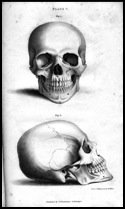Is craniometry scientific?
Wed, May 13 2009 02:07 | Biological Anthropology, Scepticism | Permalink

Craniometric studies were, to a large degree, racially motivated in the early decades of the twentieth century, with anthropologists trying to validate their preconceived racial categories. In 1912, Franz Boas published a study challenging the prevailing notion that certain cranial measurements were under ironclad genetic control. He studied the head form of some 13,000 European immigrants and their American-born children. He found significant differences in the shape of the heads between parents and their children, which he interpreted as evidence for cranial plasticity. In other words, environment, not genetics, shapes cranial morphology. During the subsequent decades, Boas' results came to be largely accepted by the anthropological community, with students of the Boasian school disregarding craniometric studies as an ill-fated enterprise. For many years, anthropologists steered clear of craniometry, instead focusing their expertise in other less stigmatised areas of physical anthropology such as palaeopathology.
Quite recently papers by Sparks et al (2002) and Gravlee et al (2003) have re-examined Boas' original data. However, those expecting the final word on cranial plasticity were to be disappointed. The anthropologist Milford Wolpoff is quoted as saying in 1975 "The data do not speak for themselves. I have been in rooms with data and listened very carefully. They never said a word." This is particularly true of these two papers, which use the very same data to come to divergent conclusion. While Gravlee et al believe Boas to be essential correct, Sparks et al came down firmly on the other side. The real answer, I believe, is to be found between the lines.
Boas did, in fact, find a statistically significant environmental effect in his study but this begs the question of whether it is a meaningful effect. Sparks suggests that while the effect is real, it only constitutes a tiny proportion of variation. In fact, considering the size of Boas' sample (~13,000) it is almost impossible not to find statistically significant results; biology is, after all, intrinsically variable. It may be the case that Boas played up the importance of the environmental effects as a reaction to the racial thinking that was prevalent at that time.
Perhaps, the biggest problem with Boas' methodology was his reliance on only a handful of measurements and particularly the use of the cephalic index (ratio of head breadth to head length). Anders Retzius introduced the cephalic index as way of classifying skulls based on their overall shape. He defined three main categories: dolichocephalic (long headed), brachycephalic (broad headed) and mesocephalic (intermediate headed).
Most modern biological anthropologists are of the opinion that the use of a couple of measurements to describe a multi-complex structure such as the skull is absurd. Today, biological anthropologist will take dozens of measurements of the skull. W. W. Howells, who measured thousands of skulls from all over the world, had the following to say about the cephalc index: "When Anders Retzius, a century and half ago, invented the cranial index, he gave us an answer for which there was no question." Even Boas himself wrote the following in 1940: "Measurements should always have a biological significance. As soon as they lose their significance they lose also their descriptive value."
Craniometry is used today in biological anthropology as a means of determining the relationships of peoples through their phenotype. A phenotype is the visible manifestation of a genotype. Since there is rarely a one to one relationship between the genotype and phenotype we must first demonstrate that the phenotype is an accurate reflection of the genotype. If this is not the case craniometry would be no more scientific than phrenology. Narrow-sense heritability is the proportion of phenotypic variation that arises from only the additive genetic differences among individuals and is expressed as h2 = VA/VP. Heribtaility is measured on a scale of 0 (no heritable variation) to 1 (all phenotypic variation is due to additive genetic effects). The average cranial h2 has been estimated at around 0.55 (Relethford 1994; Devor 1987). A heritability greater than 0.5 indicates that most phenotypic variation is the examined traits are attributable to genetic factors. Thus the proportionality of genotypic to phenotypic variance is a reasonable assumption. The true litmus test of any hypothesis is its predictive power. Craniometric data is used with surprising accuracy by forensic anthropologists to determine likely ancestry of unknown individual and by palaeoanthropologists to determine our relationship to other hominins. The modern scientific practice of craniometry distinguishes itself from psuedosciences like phrenology and physiognomy in that it is based on sound biological theory, it is testable, it is predictive and objective.
References cited
Boas F (1912) Changes in the bodily form of descendants of immigrants. American Anthropologist 14: 530-562.
Sparks CS, Jantz RL (2002) A reassessment of human cranial plasticity: Boas revisited. Proc. Natl. Acad. Sci. USA 99: 14636-14639.
Gravlee CC, Bernard HR, Leonard WR (2003) Heredity, Environment, and Cranial Form: A Reanalysis of Boas's Immigrant Data. American Anthropologist.
Devor EJ (1987) Transmission of human craniofacial dimensions. J Craniofac Genet Dev Biol 7: 95-106.
Relethford JH (1994) Craniometric variation among modern human populations. Am J Phys Anthropol 95: 53-62.
